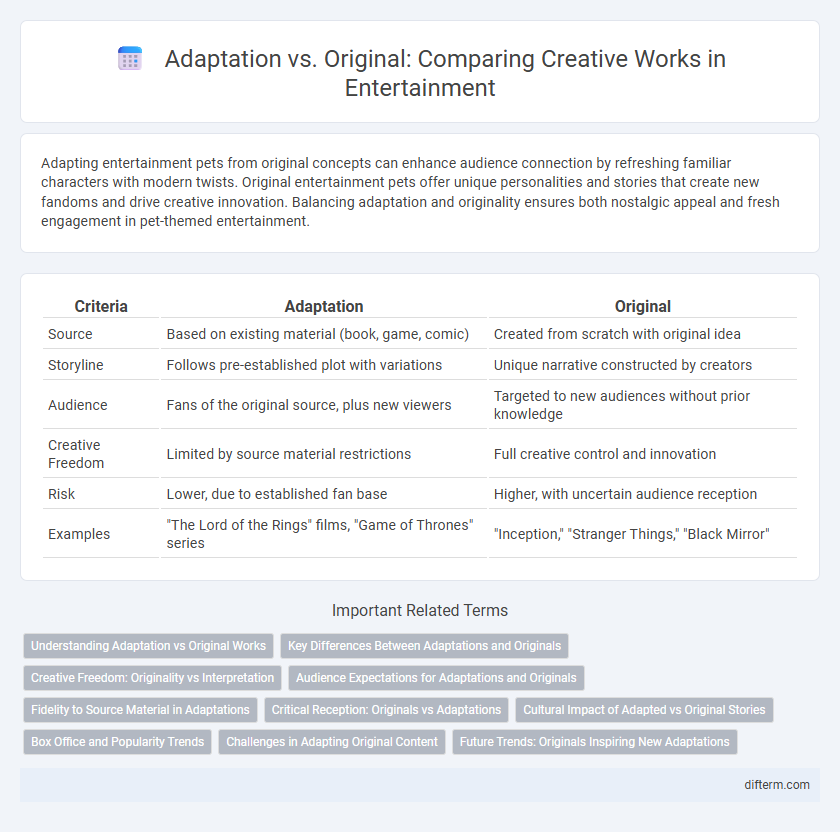Adapting entertainment pets from original concepts can enhance audience connection by refreshing familiar characters with modern twists. Original entertainment pets offer unique personalities and stories that create new fandoms and drive creative innovation. Balancing adaptation and originality ensures both nostalgic appeal and fresh engagement in pet-themed entertainment.
Table of Comparison
| Criteria | Adaptation | Original |
|---|---|---|
| Source | Based on existing material (book, game, comic) | Created from scratch with original idea |
| Storyline | Follows pre-established plot with variations | Unique narrative constructed by creators |
| Audience | Fans of the original source, plus new viewers | Targeted to new audiences without prior knowledge |
| Creative Freedom | Limited by source material restrictions | Full creative control and innovation |
| Risk | Lower, due to established fan base | Higher, with uncertain audience reception |
| Examples | "The Lord of the Rings" films, "Game of Thrones" series | "Inception," "Stranger Things," "Black Mirror" |
Understanding Adaptation vs Original Works
Adaptation involves transforming existing source material into a new format, often adjusting themes and characters to suit different media, while original works are created from an entirely new concept or story. Understanding adaptation requires analyzing how changes impact narrative structure, audience reception, and thematic depth compared to the untouched originality of source content. This distinction highlights the creative challenges in preserving essence versus innovation within entertainment productions.
Key Differences Between Adaptations and Originals
Adaptations transform existing source material such as novels, comics, or plays into new media formats, often altering plot elements or character designs to suit different audiences and platforms. Originals are unpremeditated creations developed directly for their specific medium, showcasing unique storylines and characters without pre-existing constraints. The key difference lies in the balance between creative innovation in originals and the interpretative fidelity or transformation present in adaptations.
Creative Freedom: Originality vs Interpretation
Creative freedom in entertainment often thrives more in original works, where creators shape unique narratives and characters without limitation. Adaptations require balancing fidelity to source material with innovative interpretation that can risk straying from fans' expectations. Originality allows unrestricted world-building and thematic exploration, while adaptation challenges artists to creatively reimagine existing stories within established frameworks.
Audience Expectations for Adaptations and Originals
Audience expectations for adaptations often revolve around faithful representation of beloved source material, with a strong desire for recognizable characters and plot elements that honor the original work's tone and style. Originals, by contrast, attract viewers seeking novel stories and fresh concepts, offering unpredictability and creative freedom that can lead to more innovative entertainment experiences. Meeting these distinct expectations influences the critical and commercial success of both adaptations and original productions in the entertainment industry.
Fidelity to Source Material in Adaptations
Fidelity to source material in adaptations significantly influences audience reception and critical acclaim by preserving core themes and character integrity. High-fidelity adaptations maintain narrative structure and key plot points, ensuring fanbase loyalty and enhancing emotional resonance. Deviations often spark debate, balancing creative innovation with respect for the original work's essence in entertainment media.
Critical Reception: Originals vs Adaptations
Original works often receive praise for their creativity and fresh perspectives, establishing a unique voice that resonates with critics and audiences alike. Adaptations face heightened scrutiny due to comparisons with their source material, with success dependent on maintaining core themes while innovating to suit new formats. Critical reception tends to favor originals for originality, but well-executed adaptations can achieve acclaim by offering reinterpretations that honor and expand upon the established narrative.
Cultural Impact of Adapted vs Original Stories
Adapted stories often carry cultural significance by reinterpreting familiar narratives to reflect contemporary values, fostering a shared identity across diverse audiences. Original stories contribute to cultural evolution by introducing novel ideas and perspectives that challenge conventional norms and inspire innovation in entertainment. The cultural impact of adaptations versus originals is measured by their ability to resonate emotionally and provoke dialogue within society while shaping collective memory and artistic expression.
Box Office and Popularity Trends
Original films consistently drive higher initial box office revenues due to novelty and brand recognition, capturing audience attention with fresh narratives and unique characters. Adaptations often benefit from existing fanbases, resulting in stable long-term box office performance and sustained popularity across social media platforms. Trends indicate that while originals lead in opening weekend numbers, adaptations maintain stronger franchise loyalty and merchandise sales over time.
Challenges in Adapting Original Content
Adapting original content involves navigating complex challenges such as maintaining the core narrative while translating it across different media formats, which can alter pacing and audience engagement. Casting decisions and visual interpretations often risk alienating existing fans if they diverge too far from the source material. Balancing creative fidelity with innovative updates requires skilled storytelling to satisfy both longtime followers and new viewers in the entertainment industry.
Future Trends: Originals Inspiring New Adaptations
Original content in entertainment increasingly serves as a catalyst for new adaptations, driving innovative storytelling across various media platforms. Future trends highlight the expanding use of original narratives to inspire diverse reinterpretations, including sequels, prequels, and spin-offs that appeal to evolving audiences. Advancements in technology and data analytics enable creators to identify which original works resonate most, ensuring adaptations align with market demand and cultural relevance.
adaptation vs original Infographic

 difterm.com
difterm.com